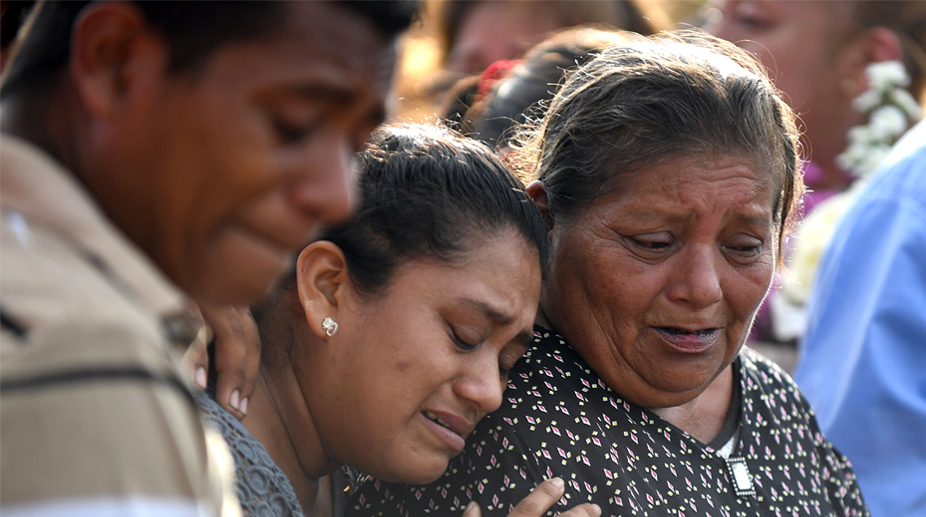Quake jolts Delhi-NCR: Authorities keeping close watch, says PM
An earthquake measuring 4.0 on the Richter scale struck Delhi-NCR in the early hours of Monday, triggering panic among residents.

(Photo: AFP)
One of the most powerful earthquakes ever recorded in Mexico struck off the country’s southern coast, toppling hundreds of buildings and sending panicked people fleeing into the streets in the middle of the night.
At least 60 people were reported dead.
Advertisement
The quake that hit minutes before midnight Thursday was strong enough to cause buildings to sway violently in the capital city more than 650 miles (1,000 kilometres) away. As beds banged against walls, people still wearing pyjamas ran out of their homes and gathered in frightened groups.
Advertisement
Rodrigo Soberanes, who lives near San Cristobal de las Casas in Chiapas, the state nearest the epicentre, said his house “moved like chewing gum.”
The furious shaking created a second national emergency for Mexican agencies already bracing for Hurricane Katia on the other side of the country.
The system was expected to strike the Gulf coast in the state of Veracruz early today as a Category 2 storm that could bring life-threatening floods.
The head of Mexico’s civil defence agency confirmed the deaths of 45 people in the southern state of Oaxaca.
Another 12 people died in Chiapas and three more in the Gulf coast state of Tabasco.
The worst-hit city appeared to be Juchitan, on the narrow waist of Oaxaca known as the Isthmus. About half of the city hall collapsed in a pile of rubble, and streets were littered
with the debris of ruined houses.
Mexico’s capital escaped major damage, but the quake terrified sleeping residents, many of whom still remember the catastrophic 1985 earthquake that killed thousands and
devastated large parts of the city.
Families were jerked awake by the grating howl of the capital’s seismic alarm. Some shouted as they dashed out of rocking apartment buildings. Even the iconic Angel of Independence Monument swayed as the quake’s waves rolled through the city’s soft soil.
Elsewhere, the extent of destruction was still emerging. Hundreds of buildings collapsed or were damaged, power was cut at least briefly to more than 1.8 million people and
authorities closed schools Friday in at least 11 states to check them for safety.
The earthquake’s impact was blunted somewhat by the fact that it was centred 100 miles offshore. It hit off Chiapas’ Pacific coast, near the Guatemalan border with a magnitude of 8.1 equal to Mexico’s strongest quake of the past century.
It was slightly stronger than the 1985 quake, the US Geological Survey said.
The epicentre was in a seismic hotspot in the Pacific where one tectonic plate dives under another. These subduction zones are responsible for producing some of the biggest quakes in history, including the 2011 Fukushima disaster and the 2004 Sumatra quake that spawned a deadly tsunami.
The quake struck at 11.49 (local time) Thursday. Its epicentre was 102 miles (165 kilometres) west of Tapachula in Chiapas, with a depth of 43.3 miles (69.7 kilometres), the
USGS said.
Dozens of strong aftershocks rattled the region in the following hours.
Three people were killed in San Cristobal, including two women who died when a house and a wall collapsed, Chiapas Gov Manuel Velasco said.
“There is damage to hospitals that have lost energy,” he said. “Homes, schools and hospitals have been damaged.”
In Tabasco, one child died when a wall collapsed, and an infant died in a children’s hospital when the facility lost electricity, cutting off the ventilator, Gov Arturo Nunez said.
The quake triggered tsunami warnings and some tall waves, but there was no major damage from the sea. Authorities briefly evacuated a few residents of coastal Tonala and Puerto Madero because of the warning.
The Pacific Tsunami Warning Centre reported waves of 3.3 feet (1 meter) above the tide level off Salina Cruz, Mexico.
Smaller tsunami waves were observed on the coast or measured by ocean gauges elsewhere.
In neighbouring Guatemala, President Jimmy Morales appeared on national television to call for calm while emergency crews surveyed damage. Officials later said only four people had been injured and several dozen homes damaged.
The quake occurred near the point of collision between three tectonic plates, the Cocos, the Caribbean and the North American.
The area has seen at least six other quakes of magnitude 7.0 or greater since 1900. Three of those occurred within a nerve-wracking nine-month span in 1902-1903, according to
Mexico’s National Seismological Service.
Scientists were still reviewing data, but a preliminary analysis indicated the quake was triggered by the sudden breaking or bending of the Cocos plate, which dives beneath
Mexico. That type of process does not happen often in subduction zones. Usually, big quakes in subduction zones occur along the boundary between the sinking slab and the overriding crust.
“It’s unusual, but it’s not unheard of,” said seismologist Susan Hough of the USGS, describing how stresses on the seafloor can produce big earthquakes.
The new quake matched the force of a magnitude 8.1 quake that hit the country on June 3, 1932, roughly 300 miles (500 kilometres) west of Mexico City.
A study by the seismological service concluded that that quake killed about 400 people and caused severe damage around the port of Manzanillo. A powerful aftershock that hit 19 days later caused a tsunami that devastated 15 miles (25 kilometres) of coastline, killing 75 people.
Advertisement